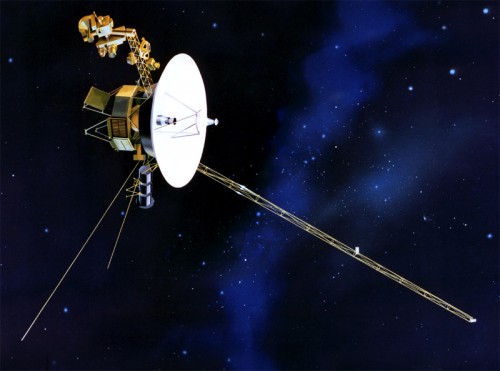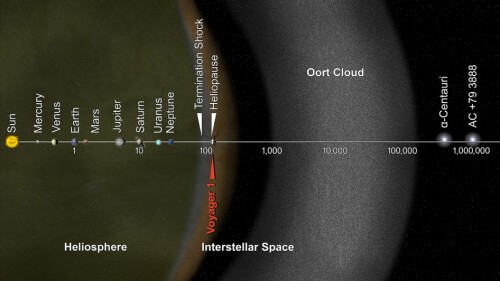After several years of suspicions, and an in-depth analysis of Voyager sensor data that arrives at a rate of only 160 bits per second, the scientists were able to determine that the spacecraft had already left the heliosphere a year ago

The Voyager 1 spacecraft is now officially the first man-made object to fly in interstellar space. The 36-year-old spacecraft now travels about 19 billion kilometers from the Sun.
New and unexpected data indicate that Voyager 1 has been moving for about a year through plasma, or ionized gas, the most prominent component of interstellar space. Voyager is now in the transition region outside the solar bubble, and some of the effects of the sun are still visible on it. However, a report on her situation prepared by a team led by Don Garnett (Gurnett) from the University of Iowa, was published on Thursday in the journal Science.
"Now, with the new information we have, I believe this is humanity's historic leap into interstellar space," says Ed Stone, Voyager project scientist from the California Institute of Technology in Pasadena. "The Voyager team needed time to analyze the observations and find the logic in them, but we can already answer the question we are all asking - are we already in interstellar space and the answer is yes, we are there."
Voyager 1 first discovered the increasing pressure of interstellar space on the heliosphere – the bubble of charged particles that surrounds the Sun and reaches beyond the outer planets in 2004. Scientists have since intensified their search for further evidence of the spacecraft's exit into the interstellar medium knowing that analyzing and interpreting the data may take months or even years.

Voyager 1 does not have an active plasma sensor, so the scientists need several ways to measure the plasma environment and arrive at a determination as to its location. Coronal mass ejections - large bursts of the solar wind and magnetic fields that erupted from the sun in March 2012 provided scientists with the required data. When this unexpected gift from the sun finally arrived at Voyager 1's location 13 months later in April 2013, the plasma around the spacecraft began to vibrate like violin strings. On April 9, a device on the spacecraft detected the movement. The height of the oscillation helped scientists determine the plasma density. The specific oscillation indicated that the spacecraft was bathed in plasma with a concentration 40 times greater than what it encountered in the outer layers of the heliosphere. This kind of density is expected only in interstellar space.
The science team tracking the plasma waves examined the data and found that earlier series of milder tremors occurred in October and November 2012. By extrapolating plasma density measurements from these events, team members determined that Voyager 1 entered interstellar space in August 2012.
Voyager Project Control Center personnel are still receiving data from Voyager 1 and Voyager 2 every day. Since the signals transmitted by the spacecraft are already very weak, and are transmitted with a power of about 23 watts - about the power of the light bulb in the refrigerator, by the time they reach the earth, they have a power of a billion-billionth of a watt left. Voyager 1's data is translated to a rate of 160 bits per second, and requires stations with dishes 34-70 meters in diameter in NASA's Deep Space Network. The signals, which travel at the speed of light, take 17 hours to reach Earth from Voyager 1. Only after the data is transmitted to JPL and processed by the scientific teams, can it be released to the public.
A NASA video from yesterday (Thursday) describing Voyager 1's departure into interstellar space
For information on the NASA website
More of the topic in Hayadan:
- Voyager 1 is about to leave for interstellar space (July 2013)
- Voyager 1 Left Behind the Solar Wind (2010)
And another video - listen to the sounds recorded by Voyager 1 in interstellar space

7 תגובות
Respect for humanity...
But still pay attention to the calculation I thought if now the Helios spacecraft would come out of the sun and from there
In 14 years she would have passed Voyager 1 at most of her speed
New Horizons was also faster but it slows down its speed
And now she's slower than Voyager 2 even..
But a significant achievement .. and if Voyager 1 came out already last year
This means that Vegar 2 will join in another 6-7 years or so..
Today Kippur and the righteous have absolutely nothing to do with anything, another desperate attempt to scribble religion into science.
Without naming names, I think whoever is defaming NASA here is the shame.
The spacecraft was launched into space 36 years ago, still provides fascinating information, and is more than twice the distance to poor Pluto.
I don't think that a body that is able to succeed in such a project, for such a long time, should be ashamed of itself. The one who needs a little modesty is one Judas...
Look at the point, dear, if we assume the distance to Proxima is a meter, then Viagra is still in the first mm, so a little modesty!
It's interstellar space, is it? Shame!
It is clear to me that everyone related to the precious gravity of our sphere is completely in our yard and not in interstellar space!
It's really a frosty day and I don't want to mess with NASA.
Happy holiday and a light fast
Asking the righteous to continue fasting and not to break, the fate of the nation of Israel is in your hands
Heaven forbid, not in the hands of interstellar space
Yehuda
The Oort cloud is in interstellar space.
Voyager definitely left the solar system by our definitions of the solar system.
Even if there are comets that come from more distant places this still does not make them part of the solar system.
You can define as you want. It can be said that leaving the solar system will only be considered when the sun appears to be a certain size...
Is this interstellar space??, I didn't know NASA knew how to tell jokes. So let's think 19 billion km is SA 127 astronomical units which are SA two thousandths of a light year. So to say that interstellar space is here when we haven't even reached the Oort cloud that envelops our precious sun, is really an exaggeration! Soon NASA will hold a big press party and announce the sensational news, but it seems to me that the interstellar space is at least half way to the nearest star to us, Proxima Centauri, which is four light years away, about a quarter of a million astronomical units.
So see you in 30,000 years!!
Please respond gently
Sabdarmish Yehuda